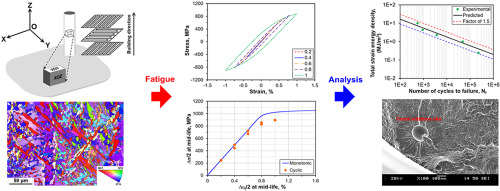当前位置:
X-MOL 学术
›
J. Alloys Compd.
›
论文详情
Our official English website, www.x-mol.net, welcomes your
feedback! (Note: you will need to create a separate account there.)
Microstructure and cyclic deformation behavior of a 3D-printed Ti–6Al–4V alloy
Journal of Alloys and Compounds ( IF 5.8 ) Pub Date : 2020-06-01 , DOI: 10.1016/j.jallcom.2020.153971 Y.L. Zhang , Z. Chen , S.J. Qu , A.H. Feng , G.B. Mi , J. Shen , X. Huang , D.L. Chen
Journal of Alloys and Compounds ( IF 5.8 ) Pub Date : 2020-06-01 , DOI: 10.1016/j.jallcom.2020.153971 Y.L. Zhang , Z. Chen , S.J. Qu , A.H. Feng , G.B. Mi , J. Shen , X. Huang , D.L. Chen

|
Abstract The main purpose of this investigation was to identify microstructure and cyclic deformation behavior of a 3D-printed Ti–6Al–4V alloy via selective electron beam melting (SEBM). Abundant orientated α-lamellae were present in the prior columnar β grains along the building direction. Four distinct high-angle α/α grain boundaries were detected as stipulated by the Burgers orientation relationship in the β→α phase transformation at a relatively slow cooling rate during SEBM, including the unique low-energy prismatic/basal (PB) grain boundaries with a misorientation angle of 90° in the 3D-printed Ti–6Al–4V alloy. The alloy exhibited superior strength and adequate ductility, along with a certain extent of strain-rate sensitivity. Cyclic stabilization largely sustained, while cyclic softening occurred at higher strain amplitudes. Although fatigue life could be described by Smith, Watson and Topper (SWT) model, it would be better predicted via a total strain energy-based model. Crack initiation occurred from near-surface defects of entrapped gas pores or residual unmelted zones, and crack propagation was characterized by typical fatigue striations. The results obtained would help promote the safe and reliable applications of 3D-printed titanium components.
中文翻译:

3D 打印 Ti-6Al-4V 合金的显微组织和循环变形行为
摘要 本研究的主要目的是通过选择性电子束熔化 (SEBM) 确定 3D 打印 Ti-6Al-4V 合金的微观结构和循环变形行为。沿构建方向在先前的柱状β晶粒中存在大量定向的α-薄片。在 SEBM 过程中以相对较慢的冷却速度在 β→α 相变中的 Burgers 取向关系规定,检测到四个不同的大角度 α/α 晶界,包括独特的低能棱柱/基底 (PB) 晶界3D 打印的 Ti-6Al-4V 合金中的取向角为 90°。该合金表现出优异的强度和足够的延展性,以及一定程度的应变率敏感性。循环稳定在很大程度上得以持续,而循环软化发生在较高的应变幅度下。虽然疲劳寿命可以通过 Smith、Watson 和 Topper (SWT) 模型来描述,但通过基于总应变能的模型可以更好地预测。裂纹萌生源于夹带气孔或残留未熔区的近表面缺陷,裂纹扩展具有典型的疲劳条纹。获得的结果将有助于促进 3D 打印钛部件的安全可靠应用。
更新日期:2020-06-01
中文翻译:

3D 打印 Ti-6Al-4V 合金的显微组织和循环变形行为
摘要 本研究的主要目的是通过选择性电子束熔化 (SEBM) 确定 3D 打印 Ti-6Al-4V 合金的微观结构和循环变形行为。沿构建方向在先前的柱状β晶粒中存在大量定向的α-薄片。在 SEBM 过程中以相对较慢的冷却速度在 β→α 相变中的 Burgers 取向关系规定,检测到四个不同的大角度 α/α 晶界,包括独特的低能棱柱/基底 (PB) 晶界3D 打印的 Ti-6Al-4V 合金中的取向角为 90°。该合金表现出优异的强度和足够的延展性,以及一定程度的应变率敏感性。循环稳定在很大程度上得以持续,而循环软化发生在较高的应变幅度下。虽然疲劳寿命可以通过 Smith、Watson 和 Topper (SWT) 模型来描述,但通过基于总应变能的模型可以更好地预测。裂纹萌生源于夹带气孔或残留未熔区的近表面缺陷,裂纹扩展具有典型的疲劳条纹。获得的结果将有助于促进 3D 打印钛部件的安全可靠应用。











































 京公网安备 11010802027423号
京公网安备 11010802027423号